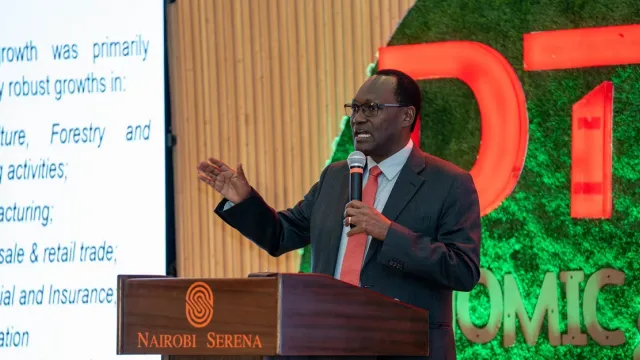Kenya’s economy is expected to expand by five percent in 2025, with the National Treasury attributing this growth to improved macroeconomic conditions, declining inflation, and a stable exchange rate.
Speaking at the Diamond Trust Bank Economic Forum, Treasury Principal Secretary Chris Kiptoo pointed to key indicators that demonstrate economic resilience. He noted that interest rates were easing, following a decision by the Central Bank of Kenya (CBK) to lower the Central Bank Rate (CBR) to ten point seven five percent. Commercial banks have also reduced lending rates, a move aimed at stimulating private sector credit uptake.
“Kenya’s economy is strong, and we have always overcome the challenges we face. Inflation has come down. A two-kilogram packet of sugar or maize has seen a huge reduction in prices,” Kiptoo said.
He further explained that adjustments in monetary policy, including changes in CBR and cash rates, had increased liquidity in banks, leading to an adjustment in interest rates.
Despite these gains, Kiptoo acknowledged that the budget deficit—projected at eight hundred sixty-two point seven billion shillings—remains a challenge. Revenue collection also fell short by ninety-two point six billion shillings in January, underscoring the need for enhanced fiscal discipline.
“We still need to balance the budget. We have challenges because of revenue-raising measures to match our expenditure. But we have seen good progress,” he said.
The Treasury’s projection of five point three percent growth in 2025 is slightly below the CBK’s December 2024 forecast of five point five percent. In an earlier statement, CBK estimated that the economy would expand by five point five percent in 2025 and five point one percent in 2024, supported by growth in services, agriculture, and improved export performance.
According to the draft 2025 Budget Policy Statement, economic activity slowed in the first half of 2024, with real GDP growth averaging four point eight percent—lower than the five point five percent recorded in the same period of 2023. Growth further dropped to four percent in the third quarter of 2024, marking the slowest expansion in four years. This decline was attributed to contractions in key sectors, including construction, mining, and quarrying.
Treasury Cabinet Secretary John Mbadi confirmed this slowdown, stating, “Economic growth is estimated to have slowed to four point six percent in 2024 from five point six percent in 2023, reflecting a deceleration of economic activity in the first three quarters of 2024 and the slowdown in private sector credit growth to key sectors of the economy.”
However, he expressed optimism about the economic outlook, adding, “Growth is expected to pick up to five point three percent in 2025 and maintain that momentum over the medium term, largely driven by enhanced agricultural productivity, a resilient services sector, and the ongoing implementation of priorities under the Bottom-Up Economic Transformation Agenda (BETA).”
Kenya’s economic trajectory has seen notable fluctuations in recent years. In 2021, the economy posted a strong rebound of seven point six percent, recovering from the near-stagnation of zero point three percent in 2020 due to the Covid-19 pandemic. Growth rates stood at five point one percent in 2019, four point nine percent in 2022, and five point six percent in 2023.
However, the International Monetary Fund (IMF) revised Kenya’s real GDP growth projections downward in late 2024, estimating a five percent expansion for both 2024 and 2025. This revision positioned Kenya as the only middle-income African country that the IMF did not expect to experience a full economic recovery in 2025.
On a global scale, economic growth in advanced economies is projected to remain steady at one point eight percent in both 2024 and 2025, a slight increase from one point seven percent in 2023.
In the United States, the economy is expected to grow by two point eight percent in 2024, driven by strong consumer spending and non-residential investments. However, this growth is forecast to slow to two point two percent in 2025 due to tighter fiscal policies and a cooling labor market.
Meanwhile, the eurozone is projected to recover, supported by improved exports, rising domestic demand, increasing real wages, and a gradual easing of monetary policy. In contrast, Japan’s growth is expected to decelerate, influenced by supply chain disruptions and the fading impact of factors such as a surge in tourism that had temporarily boosted economic activity in 2023.







